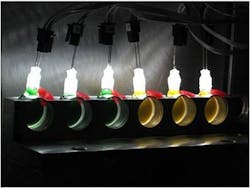To study photosynthesis in cyanobacteria, researchers at the Center for Structural Molecular Biology (CSMB) at the Oak Ridge National Laboratory (Oak Ridge, TN) have found that a light-emitting diode (LED) lighting tool can fix to their samples and then push directly into a neutron beam to illuminate light response.
Performed at the Biological Small-Angle Neutron Scattering Instrument (Bio-SANS) instrument at the High Flux Isotope Reactor at the CMSB, the lighting tool used in the study is the work of graduate student Brad O'Dell from Cambridge University (Cambridge, England). The device combines LEDs with the electronics that drive the illumination, and could facilitate research into biologically inspired solar cell devices.
At the Bio-SANS, the cyanobacteriaâa blue-green algae found in almost every environmentâare loaded into cuvettes, and an LED is fixed to the top of each cuvette. The array is then pushed into the sample holder and the neutron beam passes through a window, taking "pictures" of the response of the layers of the bacteria to variations in light from the attached LEDs.
Neutron scattering from pushing the samples into the neutron beam enables the researchers to observe how the structure changes, depending on how much light of which color they shine on the samples, says Volker Urban, lead instrument scientist on the Bio-SANS. The research team's goal is to find out how nature has solved the problem of optimizing the efficient use of solar energy through these intricate architectures of antennas. These collect sunlight and funnel the light energy to reaction centers, where it is converted into chemical energy that can be stored for further use, which could lead to new, more efficient solar panels, he says.
In related recent work, Urban and his collaborators performed small-angle neutron scattering studies to obtain structural information about the photosynthetic apparatus of the light-harvesting chlorosome complex, the light-harvesting B808-866 complex, and the bacterium Chloroflexus aurantiacus. "To our knowledge, this was the first SANS report regarding the overall photosynthetic machinery of Cfx. Aurantiacus," Urban said.
Subsequently, the researchers studied in greater detail the light-harvesting antenna chlorosome. Chlorosomes, from green photosynthetic bacteria, are the largest and one of the most efficient light-harvesting antenna complexes found in nature. The chlorosome is able to absorb solar energy and convert it into chemical energy under both low- and high-light conditions. Its unique properties make it an attractive candidate for developing biohybrid solar cell devices.
The paper that resulted was the first to investigate the ionic strength effects of chlorosomes, whose size, shape, and orientation of the light-harvesting complexes are critical to understand for the phenomenon of electron transfer to semiconductor electrodes in solar devices.
"These studies are useful for developing biomimetic and bioanalytical solar cell devices, and for demonstrating that chlorosomes are alternatives to other protein-pigment complexes produced in photosynthetic organisms," says Urban.
For more information, please visit http://parc.wustl.edu/research/publications.
-----
Follow us on Twitter, 'like' us on Facebook, and join our group on LinkedIn
Follow OptoIQ on your iPhone; download the free app here.
Subscribe now to BioOptics World magazine; it's free!
